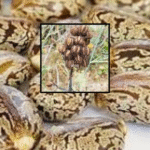Castor seed (Ricinus communis) is a vital industrial oilseed crop known for its high oil content and diverse applications in pharmaceuticals, cosmetics, and lubricants. In Pakistan, castor seed cultivation has been a part of traditional dryland farming systems, especially in arid and semi-arid regions. This article explores the historical trends in the area, production, and productivity of castor seed in Pakistan from 1947 to 2024, highlighting key changes and factors influencing these trends.
Area of Castor seed Pakistan Source: CRS, PBS, Agriculture Statics of Pakistan
|
YEAR
|
Punjab
|
Sindh
|
KPK
|
Balochistan
|
Pakistan
|
|
1970-71
|
1.02
|
23.32
|
0
|
11.04
|
35.38
|
|
1971-72
|
1
|
0.55
|
0
|
1.68
|
3.23
|
|
1972-73
|
0.82
|
0.22
|
0.03
|
0.14
|
1.21
|
|
1973-74
|
1.14
|
24.26
|
0.03
|
4.1
|
29.53
|
|
1974-75
|
1.66
|
0.89
|
0.03
|
0.25
|
2.83
|
|
1975-76
|
0.5
|
22.87
|
0.01
|
3.92
|
27.3
|
|
1976-77
|
1.53
|
31.51
|
0
|
4.63
|
37.67
|
|
1977-78
|
0.57
|
38.42
|
0.01
|
3.83
|
42.83
|
|
1978-79
|
1
|
108.39
|
0.01
|
4.23
|
113.63
|
|
1979-80
|
0.74
|
52.6
|
0
|
3.86
|
57.2
|
|
1980-81
|
0.99
|
52.62
|
0
|
4.37
|
57.98
|
|
1981-82
|
1.31
|
52.69
|
0
|
1.54
|
55.54
|
|
1982-83
|
1.04
|
52.8
|
0
|
24
|
77.84
|
|
1983-84
|
1.07
|
45.24
|
0
|
27.5
|
73.81
|
|
1984-85
|
0.6
|
36.31
|
0
|
28.69
|
65.6
|
|
1985-86
|
0.88
|
35.61
|
0
|
29.81
|
66.3
|
|
1986-87
|
0.48
|
35.61
|
0
|
1.23
|
37.32
|
|
1987-88
|
0.31
|
0.32
|
0
|
0.78
|
1.41
|
|
1988-89
|
0.26
|
30.51
|
0
|
1.6
|
32.37
|
|
1989-90
|
0.5
|
36.18
|
0
|
2.1
|
38.78
|
|
1990-91
|
0.16
|
36.73
|
0
|
0.45
|
37.34
|
|
1991-92
|
0.29
|
6.44
|
0
|
0.81
|
7.54
|
|
1992-93
|
0.44
|
7.04
|
0
|
11.76
|
19.24
|
|
1993-94
|
0.22
|
4.47
|
0
|
0.65
|
5.34
|
|
1994-95
|
0.16
|
7.67
|
0
|
16.9
|
24.73
|
|
1995-96
|
0.21
|
7.67
|
0
|
20.31
|
28.19
|
|
1996-97
|
0.14
|
5.55
|
0
|
9.88
|
15.57
|
|
1997-98
|
0.05
|
6.13
|
0
|
11.29
|
17.47
|
|
1998-99
|
0.46
|
9.27
|
0
|
9.88
|
19.61
|
|
1999-2000
|
0.19
|
5.53
|
0
|
4.94
|
10.66
|
|
2000-01
|
0.1
|
4.99
|
0
|
0.16
|
5.25
|
|
2001-02
|
0.23
|
6.15
|
0
|
0.16
|
6.54
|
|
2002-03
|
0.26
|
4.07
|
0
|
0.49
|
4.82
|
|
2003-04
|
0.42
|
8.08
|
0
|
1.22
|
9.72
|
|
2004-05
|
0.22
|
5.7
|
0
|
2.47
|
8.39
|
|
2005-06
|
0.12
|
6.14
|
0
|
1.66
|
7.92
|
|
2006-07
|
0.11
|
10.6
|
0
|
1.8
|
12.51
|
|
2007-08
|
0.17
|
5.55
|
0
|
3.09
|
8.81
|
|
2008-09
|
0.11
|
5.3
|
0
|
14.9
|
20.31
|
|
2009-10
|
0.09
|
1.22
|
0
|
2.04
|
3.35
|
|
2010-11
|
0.07
|
1.57
|
0
|
6.75
|
8.39
|
|
2011-12
|
0.06
|
1.57
|
0
|
8.43
|
10.06
|
|
2012-13
|
0.04
|
0.92
|
0
|
9.07
|
10.03
|
|
2013-14
|
0.04
|
0.94
|
0
|
10.03
|
11.01
|
|
2014-15
|
0.03
|
0.93
|
0
|
5.11
|
6.07
|
|
2015-16
|
0.03
|
0.87
|
0
|
3.54
|
4.44
|
|
2016-17
|
0.01
|
0.8
|
0
|
3.46
|
4.27
|
|
2017-18
|
0.01
|
0.74
|
0
|
2.96
|
3.71
|
|
2018-19
|
0
|
1.83
|
0
|
2.3
|
4.13
|
|
2019-20
|
0
|
1.83
|
0
|
2.3
|
4.13
|
|
2020-21
|
0
|
1.83
|
0
|
2.3
|
4.13
|
|
2021-22
|
0
|
2.23
|
0
|
2.72
|
4.95
|
|
2022-23
|
0
|
4.94
|
0
|
7.41
|
12.35
|
Historical Overview (1947–2024)
Since independence in 1947, Pakistan’s agricultural sector has undergone significant transformations. Castor seed, though not as prominent as wheat or cotton, has maintained a niche role in oilseed production.
Key Periods:
-
1947–1970: Limited cultivation, mostly in Sindh and Balochistan, with low productivity.
-
1971–1990: Gradual increase in area under cultivation due to demand from local oil industries.
-
1991–2010: Decline in area due to competition from other oilseed crops and lack of market support.
-
2011–2024: Renewed interest due to global demand for castor oil and its by-products.
Production of Castor seed Pakistan Source: CRS, PBS, Agriculture Statics of Pakistan
|
||||||||||||||||||||||||||||||||||||||||||||||||||||||||||||||||||||||||||||||||||||||||||||||||||||||||||||||||||||||||||||||||||||||||||||||||||||||||||||||||||||||||||||||||||||||||||||||||||||||||||||||||||||||||||||||||||||||||||||||||||||||||||||||||||||||||||||||||||||||||||||||||||||||||||||||||||||||||||||||||||||||||||
|
Productivity of Castor seed Pakistan Source: CRS, PBS, Agriculture Statics of Pakistan
|
||||||||||||||||||||||||||||||||||||||||||||||||||||||||||||||||||||||||||||||||||||||||||||||||||||||||||||||||||||||||||||||||||||||||||||||||||||||||||||||||||||||||||||||||||||||||||||||||||||||||||||||||||||||||||||||||||||||||||||||||||||||||||||||||||||||||||||||||||||||||||||||||||||||||||||||||||||||||||||||||||||||||||
|
Productivity (Yield per Hectare)
Productivity has improved over the decades, thanks to better farming practices and limited research input. However, Pakistan still lags behind countries like India and Brazil in castor seed yield.
Regional Distribution
-
Sindh and Balochistan are the primary castor seed growing provinces due to their dry climate.
-
Punjab and KPK have negligible or no castor production due to unfavorable conditions.
Challenges in Castor Seed Cultivation
-
Lack of certified seed varieties.
-
Low research and extension services.
-
Limited domestic processing industries.
-
Absence of minimum support price (MSP).
-
Export barriers and lack of awareness about global markets.
Opportunities and Way Forward
-
Promotion of castor seed as a climate-resilient crop in arid areas.
-
Development of value chains including oil extraction and cosmetics.
-
Support for contract farming with exporters and oil processors.
-
Investment in research for high-yield, pest-resistant varieties.
Conclusion
The castor seed sector in Pakistan holds untapped potential for contributing to both rural incomes and industrial development. Despite a fluctuating trend in area and production, castor seed can be revitalized with proper policy support, market linkages, and technology adoption. Going forward, sustainable castor seed farming could play an important role in dryland agriculture and the oilseed economy of Pakistan.
Trends of area, production and productivity of Barly crop in Pakistan 1947-2024
Trends of area, production and productivity of Bajra crop in Pakistan


